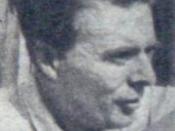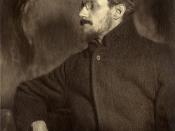4. The novel from 1881 to 1914
Over the eighteen eighties there was a split in fiction. The first indication towards it was Henry James' essay "The Art of Fiction" (1884), which referred to the novelist's calling as a "Sacred office". Besides, there appeared a stratification of fiction due to primary education for all. Parallel to this, novelists saw themselves apart from the public, as dedicated men. This new modern conception involved dignity and a sense of glory. Another change was from the three-volume novel to the one volume one. Together with the demands of the new publics, this shortening divided the Victorian novel into the categories of fiction we know today. The key name in the eighties is Henry James, who strove to give the novel the aesthetic intensity of poetry or painting. The two dominant themes in his work are the "international subject" and that of the innocent.
After the eighties the novel became the dominant prose form.
4.1. The Turn of the Century: the Modern British Novel
The turn of the century meant the end of the Victorian Era with the Queen's death in 1901. The legacy of Darwin, the Victorian loss of Christian Faith, Socialism and the awareness of threat against England's wealth increased the existing social discomfort. Apart from this, new discoveries such as Einstein's Special theory of Relativity (1905) and Freud's works Interpretation of Dreams (1900) and The Psychopathology of Everyday life (1901) were also important. As concerns Visual Arts, after the Post-Impressionist movement a great crisis of the subject followed. This crisis led to Cubism and Dadaism. Arts were then called to recognition of modern technology, which was expressed in poetry through the introduction of free verse and broken syntax. Therefore, the Modern shows its discontinuity with the past, though not completely.
4.2. Modernism and Its Alternatives
Modernism implies a sense of historical discontinuity, either liberation from inherited patterns or deprivation. Modernism runs up to the mid twenties and leaves behind names like Joseph Conrad, D.H. Lawrence, E.M. Foster, Ford Maddox Ford, James Joyce, Virginia Woolf, Gertrude Stein and Djurna Barnes in novel. Paradoxically, its first recurrent theme was the return to the past, to the primitive, which took the form of the return to the myth of the ancient world and non-European societies. Another recurrent theme was the human mind. The recent development of psychology provided explanations to somehow understand human consciousness and the irrationality of human beings. The most immediate evidence of psychology's influence is "the-stream-of-consciousness-technique" in literature, introduced by Henry James' brother and psychiatrist William James.
Contemporary with Henry James, Joseph Conrad is a Polish man who sailed for France and Britain. Not surprisingly, his most recurrent theme is the man against himself and his environment, about what happens when human beings encounter what see or experience as "Otherness". Nostromo (1904) is considered one of the most organized works in English. After him, the next group of writers to mention is E.M. Foster and D. H. Lawrence. Both explored the deep drives in human nature, as for instance in A passage to India (1924) by the former and Lady Chaterley's Lover (1928) by the latter.
In a different group, we find Virginia Woolf, Katherine Mansfield and James Joyce sharing a reaction against their naturalistic forebears and experimenting with a new approach to fiction. James Joyce experimented with "the-stream-of-consciousness" technique in his Ulysses. Later on, he tried techniques of verbal ambiguity and levels of complexity in Finnegans Wake (1939). Meanwhile, Mansfield and Woolf have been said to develop a post impressionistic principle of suggetiveness from a feminine approach. However, Virginia Woolf sought to represent the unconsciousness, as in Mrs. Dalloway (1925), and discontinuity; whereas Katherine Mansfield worked on short stories where she explored and described the mysterious diversity of life, like the ones included in her collections.
During the period between wars we find the "Jazz Age". Then, prose fiction becomes associated with simple plots, utopian worlds and literature of disillusionment. Aldous Huxley's dystopia Brave New World illustrates how worries moved beyond their time and addressed the dangers of a technologically engineered future. An extreme example of disillusionment literature is George Orwell's works, where a deception with Communism and Socialism ideals is depicted. The most relevant examples are Homage to Catalonia (1938), Animal Farm (1945) and Nineteen Eighty four (1949).
4.3. Post-War and Post-Modern Literatures and the Neo-Gothic
After World War II, there are many names that are important to quote. An example is Elizabeth Bowen. She has been associated with V.Woolf since she explored the inner emotional life, as in The Hotel (1927). After the fifties, Britain lost its overseas Empire steadily but gained a new cultural diversity.That way, Britain started building itself in a culturally, socially and economically different reality. This also had its impact on literature. The new novelists of the fifties include Samuel Beckett's experimental narrative, D.H. Lawrence, Lawrence Durrell, William Golding, Angus Wilson, Iris Murdoch and Muriel Spark.
During the 1960s and the 1970s a new morality, already sensed in Larkin's poem Annus Mirabilis (1963), appeared. This led to female and male reformulations in fiction. In the 1960s the broadening of women's opportunities and perspectives shaped social changes. The "New Morality" challenged received perceptions of gender, sex and marriage.The Female Eunuch by Germain Greer provided a stimulus to the development of provocative feminism, which became "The First Feminist Wave". Some names related to it are Doris Lessing and Margaret Drabble. Contemporary to them, Jean Rhys made women's creativity and sensibilities reach deeper levels of perception in the depictions of earlier realities. Besides, the othered doubly colonized female subject speaks in a different English while in Britain the narrative female voice of writers like Angela Carter are experimenting with intertextuality.
Another new aspect emerging during the 1960s and 1970s is Post-modern Neo-Gothic Experience, where the complexity of styles is added to the numerous layers of intertext.A representative work is The Bloody Chamber (1979), by Angela Carter. Women's works are much more interesting than their male contemporaries'. In works like John Fowle's and Anthony Burgess' A Clockwork Orange (1962) women are still dependent on a male rescuer. Contrary to this, in women's works, like in Angela Carter's and Margaret Atwood's, the female heroines are often strong enough to save themselves without the classic intervention of a male figure. Broadly speaking, "Gothicism" has been identified with provocation, a rebellion against establishment, control and the powers of restrictive ideologies. It also involves some experimental writing.
4.4. The end of the century: Notes on Late Century Fiction
British literature during the 1990s lacks big names because it is still under the strong influence of the 20th century heritage and it is less original than the literature produced in Latin America and the former Communist States of Eastern Europe. During the 1970s and the 1980s the Campus Fiction set in universities and colleges was captured by the pioneer Kingsley Amis and later writers like Malcom Bradbury and David Lodge. In the early 1990s, the novel still was the most accessible and popular genre. Literary Prizes, like the Booker Prize, increased the interest in new fiction. Besides, there was a return to the Modernists' challenges and their degree of subversion. Then, the novel reflected modernity: changes in our thoughts, movements and the fragmentation and chaos of contemporary life.
Throughout the last decades, British fiction has explored four main areas of interest:
"XNew varieties of historical writing. Jeanette Winterson (1959) experimented with lesbian and historical novels. One field that has produced a fascination for novelists is the history of the fragmented, and the fragmenting former British Empire. For instance, as regards Victorian India in the case of George MacDonald Frazer, Paul Scott and Salman Rushdie.
"XThe experience of Colonialism afterwards, the voice of the "other. The new makeup of plural identities seems to be the most fruitful arena for new fictions. A clear example lays in that recent Booker Prizes are Timothy Mo, whose mother is English and his father Cantonese (awarded in 1950); Kashuo Ishiguo, Japanese (awarded in 1989); and Arhundati Roy, Indian (awarded in 1997).
"XThe development of Gothic Tradition. As previously explained in section 4.3., works like The Bloody Chamber, Nights at the Circus, Wise Children, The Collector or A Clockwork Orange contributed to the development of Neo- Gothic experience.
"XFeminism and exploration of sexuality from a new approach (homosexuality). Angela Carter represented a newly feminist expression, which other writers like Iam McEwan (1948) and Alasdair Gray (1934) took up. One of the most significant examples of experimentation with lesbian novels is Jeanette Winterson with novels such as Oranges Are Not The Only Fruit (1985), The Passion (1987) and Sexing the Cherries (1989).


